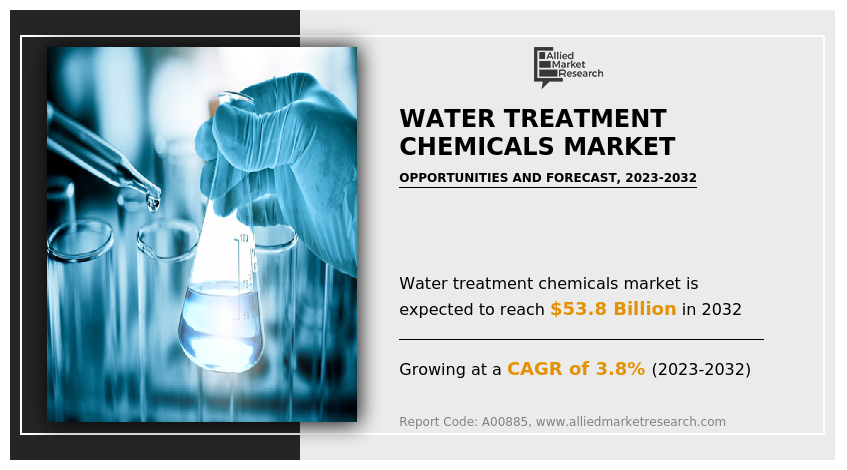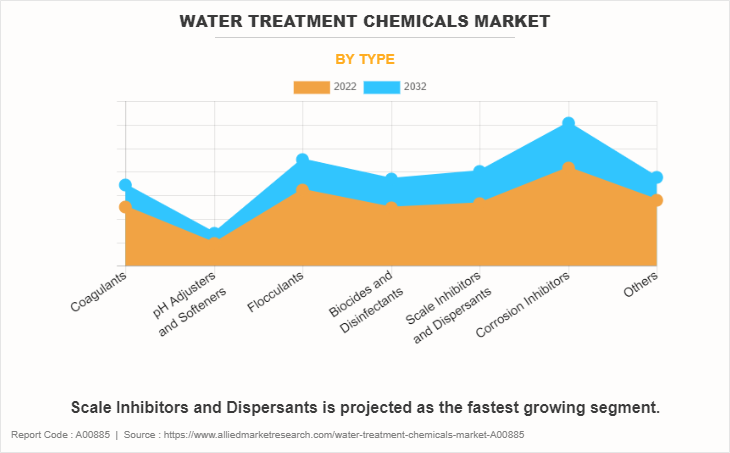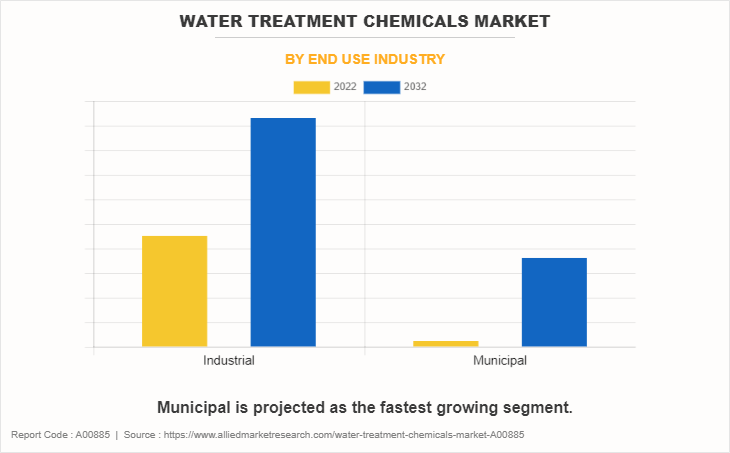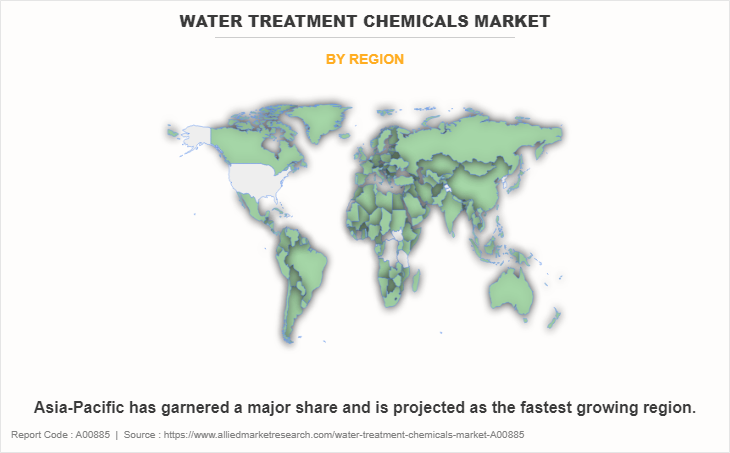Water Treatment Chemicals Market Research - 2032
The global water treatment chemicals market was valued at $37.5 billion in 2022 and is projected to reach $53.8 billion by 2032, growing at a CAGR of 3.8% from 2023 to 2032.
Report Key Highlighters:
- Quantitative information mentioned in the global water treatment chemicals market report includes the market numbers in terms of value ($Million) and volume (Kilotons) with respect to different segments, pricing analysis, annual growth rate, CAGR (2023-32), and growth analysis.
- The analysis in the report is provided based on type and end-use industry. The study will also contain qualitative information such as the market dynamics (drivers, restraints, opportunities), Porter’s Five Force Analysis, key regulations across the region, and value chain analysis.
- A few companies, including Akzo Nobel N.V., Baker Hughes Company, BASF SE, Cortec Corporation, Ecolab, Italmatch Chemicals spa, Canadian Clear, Dober, and Kemira, hold a large proportion of the water treatment chemicals market.
- This report makes it easier for existing market players and new entrants to the water treatment chemicals business to plan their strategies and understand the dynamics of the industry, which ultimately helps them make better decisions.

Water treatment chemicals are substances used to improve the quality of water by eliminating impurities and contaminants. These chemicals play a crucial role in purifying water for consumption, industrial processes, and environmental protection. Common water treatment chemicals include coagulants, flocculants, disinfectants, pH adjusters, and corrosion inhibitors. Coagulants promote the aggregation of particles, aiding in their removal through sedimentation or filtration. Flocculants encourage the formation of larger particles for easier removal.
Disinfectants, such as chlorine or ozone, eliminate harmful microorganisms. pH adjusters regulate the acidity or alkalinity of water to meet specific standards. Corrosion inhibitors protect pipes and equipment from degradation. Effective water treatment chemicals ensure compliance with regulatory standards, prevent waterborne diseases and safeguard infrastructure. Proper dosing and application of these chemicals are essential for optimizing water treatment processes and maintaining the health and safety of water supplies.
The water treatment chemicals market growth is driven by the expansion of the oil & gas industry.
As global energy demand continues to rise, the oil & gas sector experiences robust growth, leading to an increased need for water treatment solutions. According to the India Brand Equity Foundation (IBEF), India's oil demand will exceed 11 million barrels per day by 2045. As per the US Energy Information Administration (EIA), the production of crude oil grew from 10,809 barrels per day in September 2021 to 11,473 barrels per day in October 2021.
In oil & gas operations, a substantial volume of water is utilized and subsequently requires effective treatment to meet environmental standards and ensure sustainable practices. Water treatment chemicals play a pivotal role in addressing the challenges associated with the extraction and processing of oil and gas, offering solutions for wastewater management, desalination, and water reuse. An increase in awareness about environmental concerns coupled with the implementation of stringent environmental regulations further amplifies the importance of water treatment in the oil & gas sector, propelling the demand for specialized chemicals. As a result, the water treatment chemicals market is expected to witness notable growth, aligning with the thriving trajectory of the oil & gas industry.
Stringent regulatory mandates on wastewater treatment are poised to significantly influence the water treatment chemicals market size.
Regulatory bodies such as the Environmental Protection Agency (EPA), the Clean Water Act (CWA), and the Safe Drinking Water Act (SDWA) have implemented regulations to control industrial discharge and ensure proper wastewater treatment. Compliance with these stringent effluent quality standards has heightened the demand for wastewater treatment chemicals. In addition, industries are now compelled to adopt effective wastewater treatment technologies to meet these criteria and minimize their environmental footprint.
This increased regulatory pressure has created a potential opportunity for water treatment chemical producers, such as Kemira OYJ in Finland and BWA Water Additives in the UK, who specialize in providing chemicals for industrial wastewater treatment. The Wastewater Effluent Regulations established under the Fisheries Act underscore the significance of adequate wastewater treatment. These regulations set minimum effluent quality standards that businesses must adhere to protect aquatic ecosystems. Thus, the use of wastewater treatment chemicals becomes imperative to eliminate pollutants and toxins from industrial wastewater, aligning with these regulatory mandates and driving market growth.
However, the high cost of water treatment chemicals poses a significant threat to the growth of the water treatment chemicals market. Water treatment chemicals play a crucial role in maintaining water quality and ensuring safe consumption across various industries and municipalities. The increasing cost of these essential chemicals can lead to financial strain on water treatment facilities and industries reliant on water purification processes.
For instance, on February 24, 2022, Solenis, a leading global producer of specialty chemicals, raised prices across all product lines in North America and Latin America by 10–25%, or as permitted by client contracts. These price increases are necessary due to rising raw material, energy, transportation, and packaging expenses. As the prices surge, businesses may face heightened operational expenses, impacting their overall cost structure and potentially deterring investments in water treatment solutions. This, in turn, can compromise the quality of water treatment processes, leading to concerns about water safety and environmental impact. Industry must address these challenges by exploring cost-effective alternatives and innovative technologies to maintain the efficiency of water treatment processes without compromising on quality.
On the contrary, exponentially increasing global population, rapid urbanization, and robust economic development are expected to offer remunerative opportunities for the expansion of the global water treatment chemicals market share. This is attributed to the fact that the demand for clean and safe water has become paramount, thereby augmenting the need for water treatment chemicals. The rise in industrial activities accompanying economic development further boosts the need for effective water treatment solutions.
These chemicals play a crucial role in purifying water, mitigating pollutants, and ensuring compliance with stringent environmental regulations. Governments and industries globally are increasingly investing in advanced water treatment technologies, propelling market expansion. In addition, a surge in demand for potable water, coupled with the imperative to address water scarcity issues, positions the water treatment chemicals market as a key player in facilitating sustainable development and environmental stewardship on a global scale.
The global water treatment chemicals market is segmented into type, end-use industry, and region. By type, the market is fragmented into coagulants, PH adjusters & softeners, flocculants, biocides & disinfectants, scale inhibitors & dispersants, corrosion inhibitors, and others. Based on end-use industry, it is categorized into industrial and municipal. Region-wise, it is studied across North America, Europe, Asia-Pacific, and LAMEA.

The corrosion inhibitors segment accounted for the largest share in 2022. The demand for corrosion inhibitors is on the rise due to expanding industrial activities, growing infrastructure development, and the increasing use of metals in various sectors. As industries strive for efficiency and longevity, corrosion inhibitors become essential in preventing deterioration and ensuring equipment durability.
Scale inhibitors and dispersants is expected to register the highest CAGR of 4.4%. The increasing demand for scale inhibitors and dispersants is driven by the expanding industrial processes, particularly in oil and gas production. As operational scales rise, the risk of scale formation and system fouling grows, necessitating effective chemical solutions to mitigate these challenges and ensure optimal process efficiency.

The industrial segment accounted for the largest share in 2022. The escalating global focus on water quality and stringent environmental regulations are driving increased demand for water treatment chemicals in the industrial sector. Growing industrialization, coupled with the need for efficient water management, underscores the rising importance of these chemicals in sustaining industrial processes.
Municipal is expected to register the highest CAGR of 4.0%. The increasing urbanization and population growth drive demand for municipal water treatment chemicals. Stringent regulations on water quality, rising awareness of health concerns, and aging infrastructure further amplify the need for effective water treatment solutions in the municipal industry.

Asia-Pacific garnered the largest share in 2022. The increasing industrialization, population growth, and urbanization in the Asia-Pacific region have heightened the demand for water treatment chemicals. Stricter environmental regulations and rising awareness about water quality issues further contribute to the growing need for effective water treatment solutions in the region.
The major players operating in the global water treatment chemicals market include Akzo Nobel N.V., Baker Hughes Company, BASF SE, Cortec Corporation, Ecolab, Italmatch Chemicals spa, Canadian Clear, Dober, Kemira, Hydrite Chemical, Dow, Lonza, Nouryon, Solenis, Solvay, American Water Chemicals, Inc., Kurita Water Industries Ltd., SNF, US WATER SYSTEMS INC., and Veolia.
Key development strategies undertaken by key players
In November 2023, Kemira announced that its ferric sulfate water treatment chemicals production facility in Goole, UK, has been significantly expanded in capacity. The new and stricter Asset Management Plan 7 and 8 regulations on phosphorus and other nutrient discharge from wastewater treatment set out in the UK's Water Industry National Environment Programme help meet the growing demand for coagulants, which is met in part by the additional 70,000 tons of capacity investment. This expansion will strengthen the product portfolio of water treatment chemicals, leading to market growth.
In June 2021, Kemira, a leading global provider of sustainable chemicals for water-intensive industries, is expanding its water treatment chemical production capacity in Yanzhou, China. A new sodium hypochlorite production unit is being built by Kemira at the Yanzhou location. The expanding demand for water treatment in China and Asia-Pacific is addressed by these investments, which represent another advancement in the company's expansion plan, leading to the growth of the water treatment chemicals market.
In August 2022, Nouryon announced an exclusive arrangement with Brenntag Specialties, which will make Brenntag Specialties the only distributor of its unique LumaTreat tagged polymers in the U.S. and Canada. Through this agreement, water treatment professionals will gain easier access to Nouryon's wide variety of specialty polymers as well as critical parts for commercial and industrial heating and cooling systems. Brenntag will distribute a variety of Nouryon's other water treatment technologies, such as Aquatreat, Versaflex, and Versa-TL polymers, which offer scale control and dispersancy and function as deposit-control agents to stop scale and debris from adhering to the heat transfer surfaces, in addition to the patented LumaTreat tagged polymers. This agreement will boost the growth of the water treatment chemicals market.
In March 2021, Nouryon introduced LumaTreat, a novel range of water management products that are patent-filed and made of smart-tagged polymers. The fluorescent monomers used in LumaTreat products adhere to a deposit control agent. A Smart Tag that precisely monitors the amount of "free" or unused polymer in the water treatment system is made possible by the combination of the fluorescent monomer and deposit control polymer. This product launch will strengthen the demand for water treatment chemicals, leading to market growth.
In October 2023, Solenis, a leading manufacturer of specialty chemicals for water-intensive industries acquired CedarChem LLC. CedarChem offers a wide range of water and wastewater treatment products for industrial and municipal uses, primarily in the southeastern U.S. The acquisition is by Solenis' direct go-to-market approach, which aims to give customers better chemical and wastewater treatment product and service solutions.
In July 2020, Solenis completed the acquisition of Poliquímicos, S.A. de C.V. (Poliquímicos), a producer and supplier of specialized chemical solutions for water-intensive industries in Mexico. The acquisition of Poliquímicos will strengthen Solenis' direct sales channel and expand its capacity for production in Mexico, leading to the growth of the water treatment chemicals market.
Public Policies on the Water Treatment Chemicals Market:
- Environmental Protection Agency (EPA): The EPA in the U.S. regulates water quality and has established standards for various contaminants in drinking water. The Safe Drinking Water Act (SDWA) empowers the EPA to set national standards for drinking water quality and oversees the implementation of these standards.
- National Sanitation Foundation (NSF) International: NSF is an independent organization that develops standards and protocols for the certification of products, including water treatment chemicals and systems. NSF standards are widely accepted and used in North America.
- Occupational Safety and Health Administration (OSHA): OSHA regulates workplace safety in the U.S. and has guidelines related to the handling, storage, and use of water treatment chemicals in industrial settings.
- Canadian Council of Ministers of the Environment (CCME): In Canada, the CCME plays a role in coordinating environmental efforts among the federal, provincial, and territorial governments. Guidelines related to water quality and treatment be developed in collaboration with CCME.
- Provincial and State Regulations: Each province in Canada and each state in the U.S. has its regulations and guidelines regarding water treatment chemicals. These can include standards for water quality, permissible levels of contaminants, and protocols for water treatment processes.
- Local Municipal Regulations: Municipalities often have their regulations and guidelines for water treatment within their jurisdictions. Local water treatment plants must adhere to these rules to ensure the delivery of safe drinking water.
- Registration, Evaluation, Authorization, and Restriction of Chemicals (REACH): REACH is a comprehensive regulation that addresses the production and use of chemical substances, including those used in water treatment. It requires companies to register and provide information on the properties and uses of their chemical substances.
- Biocidal Products Regulation (BPR): BPR regulates the placing on the market and use of biocidal products, which include certain water treatment chemicals. It aims to ensure that these products are effective and safe for humans and the environment.
- Drinking Water Directive: The Drinking Water Directive sets standards for the quality of water intended for human consumption. It includes parameters and limits for various substances, including chemicals used in water treatment, to ensure the safety of drinking water.
- Water Framework Directive (WFD): WFD establishes a framework for the protection and sustainable use of water resources across the EU. It aims to achieve "good ecological status" in all water bodies and addresses the prevention and reduction of pollution, including from chemical substances.
- Directive 98/83/EC on the Quality of Water Intended for Human Consumption: This directive sets quality standards for drinking water and includes provisions related to the monitoring and control of chemical parameters.
- China has implemented water quality standards and regulations to address water pollution. The Ministry of Ecology and Environment (MEE) is the key regulatory body overseeing water quality. The "Environmental Protection Law of the People's Republic of China" and the "Water Pollution Prevention and Control Action Plan" are crucial documents that guide water quality management.
- The Central Pollution Control Board (CPCB) is the regulatory authority responsible for water quality management in India. The Water (Prevention and Control of Pollution) Act, 1974, and the Water (Prevention and Control of Pollution) Cess Act, 1977, are important legislations governing water pollution.
- The Water Pollution Control Law in Japan sets the framework for water quality management. The Ministry of the Environment (MOE) is responsible for overseeing water pollution control measures.
- Australia has a National Water Quality Management Strategy that outlines guidelines for water quality monitoring and management. Each state and territory has its regulations and guidelines. For example, in New South Wales, the Department of Planning, Industry, and Environment is responsible for water quality management.
- The Public Utilities Board (PUB) is the national water agency responsible for water supply and management in Singapore. Singapore has stringent water quality standards and regulations to ensure the safety of its water supply.
- The Ministry of Environment oversees water quality management in South Korea. The Water Quality and Ecosystem Conservation Act is a key legislation addressing water pollution.
Socioeconomic Impact on the Water Treatment Chemicals Market:
The ongoing Russia–Ukraine war and the persistent challenges posed by the COVID-19 pandemic have significantly impacted the global water treatment chemicals industry. The conflict in Eastern Europe has disrupted supply chains and heightened geopolitical tensions, leading to increased volatility in commodity prices, including those of crucial water treatment chemicals. The uncertainty surrounding the availability of raw materials, such as chlorine and alum, essential for water treatment processes, has resulted in supply chain disruptions and elevated production costs. This has subsequently translated into higher prices for water treatment chemicals, affecting both suppliers and end users.
Simultaneously, the COVID-19 pandemic has further strained the water treatment chemicals market. The increased focus on public health and sanitation measures to curb the spread of the virus has driven up the demand for water treatment chemicals, especially in industries such as healthcare, municipal water treatment, and pharmaceuticals. However, lockdowns, travel restrictions, and workforce shortages have impeded the production and distribution of these chemicals, causing supply–demand imbalances.
Moreover, the economic downturn triggered by the pandemic has led to budget constraints for municipalities and industrial facilities, affecting their ability to invest in water treatment solutions. As countries navigate the dual challenges of the Russia–Ukraine conflict and the ongoing pandemic, the water treatment chemicals market faces a complex landscape with shifting dynamics. Industry stakeholders must adapt to these multifaceted challenges, balancing the need for effective water treatment solutions with the economic constraints imposed by geopolitical uncertainties and the global health crisis.
Key Benefits For Stakeholders
- This report provides a quantitative analysis of the market segments, current trends, estimations, and dynamics of the water treatment chemicals market analysis from 2022 to 2032 to identify the prevailing water treatment chemicals market opportunities.
- The market research is offered along with information related to key drivers, restraints, and opportunities.
- Porter's five forces analysis highlights the potency of buyers and suppliers to enable stakeholders make profit-oriented business decisions and strengthen their supplier-buyer network.
- In-depth analysis of the water treatment chemicals market segmentation assists to determine the prevailing market opportunities.
- Major countries in each region are mapped according to their revenue contribution to the global market.
- Market player positioning facilitates benchmarking and provides a clear understanding of the present position of the market players.
- The report includes the analysis of the regional as well as global water treatment chemicals market trends, key players, market segments, application areas, and market growth strategies.
Water Treatment Chemicals Market Report Highlights
| Aspects | Details |
| Market Size By 2032 | USD 53.8 billion |
| Growth Rate | CAGR of 3.8% |
| Forecast period | 2022 - 2032 |
| Report Pages | 1108 |
| By End Use Industry |
|
| By Type |
|
| By Region |
|
| Key Market Players | Kemira, American Water Chemicals, Inc., Cortec Corporation, Dober, Akzo Nobel N.V., Baker Hughes Company, SNF, BASF SE, Dow, Ecolab, Veolia, Hydrite Chemical, Kurita Water Industries Ltd., Italmatch Chemicals S.p.A, Nouryon, Canadian Clear, Lonza, US WATER SYSTEMS INC, Solenis, Solvay |
Analyst Review
According to the insights of the CXOs of leading companies, the water treatment chemicals market has been witnessing several notable trends and developments. One prominent trend is the growing emphasis on sustainable and eco-friendly water treatment solutions. With increasing environmental awareness and stringent regulations, the demand for chemicals that have minimal environmental impact and are effective in treating water pollutants has increased considerably.
In addition, advancements in technology have spurred innovations in water treatment chemicals. Companies are investing in research and development to introduce novel chemicals that offer improved efficiency, cost-effectiveness, and safety in water treatment processes. Furthermore, nanotechnology is gaining traction, enabling the development of nano-scale water treatment chemicals for enhanced performance.
The CXOs further added that the global water scarcity issue has led to an increased focus on water reuse and recycling, driving the demand for specialized chemicals that can facilitate these processes. This includes chemicals for advanced wastewater treatment and the removal of specific contaminants such as heavy metals and emerging pollutants. As industries strive to reduce their water footprint and comply with increasingly stringent regulations, the water treatment chemicals market is expected to witness continued growth. Key players are likely to focus on strategic collaborations and partnerships to expand their product portfolios and geographical presence, ensuring they stay at the forefront of this dynamic and evolving market.
The global water treatment chemicals market was valued at $37.5 billion in 2022, and is projected to reach $53.8 billion by 2032, growing at a CAGR of 3.8% from 2023 to 2032.
The Water Treatment Chemicals Market is studied across North America, Europe, Asia-Pacific, and LAMEA.
Asia-Pacific is the largest regional market for Water Treatment Chemicals.
The global water treatment chemicals market is into type, end-use industry, and region. By type, the market is fragmented into coagulants, pH adjusters & softeners, flocculants, biocides & disinfectants, scale inhibitors & dispersants, corrosion inhibitors, and others. On the basis of end-use industry, it is bifurcated into industrial and municipal.
Municipal is the leading end-use industry of Water Treatment Chemicals Market.
The major players operating in the global water treatment chemicals market include Akzo Nobel N.V., Baker Hughes Company, BASF SE, Cortec Corporation, Ecolab, Italmatch Chemicals spa, Canadian Clear, Dober, Kemira, Hydrite Chemical, Dow, Lonza, Nouryon, Solenis, Solvay, American Water Chemicals, Inc., Kurita Water Industries Ltd., SNF, US WATER SYSTEMS INC., and Veolia.
Utilization of the 3R method of sustainability is the upcoming trend of Water Treatment Chemicals Market in the world.
Loading Table Of Content...
Loading Research Methodology...


